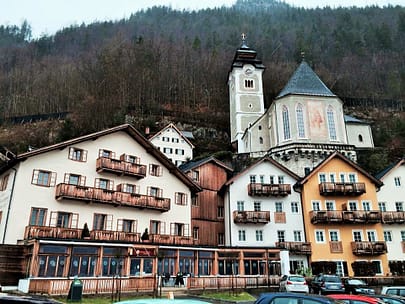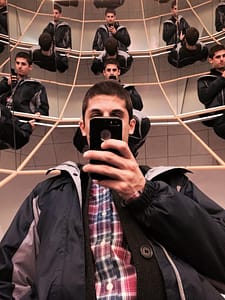Tucked between mountains, on the precipice of a lake, Hallstatt is considered to be the most beautiful lakeside village and one of the prettiest villages in the world. The whole village is a UNESCO World Heritage Site. To arrive, you must take a train, then a ferry across the lake. I had plans to stay the whole day, but due to the terrible weather (horrible rain and wind, the worst of any day) I could only manage two hours.
The city is breathtaking and beautifully layered among the mountains with its cobblestone streets and small passageways that weave through quaint residences. In the center of town and most visible in photos is the protestant church with its orange pointed steeple. They must have just renovated it because in all the photos it appears black. Next to the church is the beautifully romantic market square, lined with little shops and restaurants. During my time there, most of them were closed. After visiting the market square I made my way to the Catholic Church; another gem in the midst of this cultural village. It was built in 1181 and not finished until some years later due to its position on a steep rock face. One of the attractions of the church is its bone house. Due to the limited amount of space for burials, after some time the graves were opened and reused; the skulls removed and cleaned and then put into the bone house. Starting in the 18th century it was a habit to paint the skulls with the name of the person, the year of their death and some other decoration. In it, there are over 1,200 skulls. To my dismay, it was closed when I went.
After walking around for some bit and taking some pictures, my feet were soaked (even though I had plastic bags around my socks) and I wanted to get out of the rain, so I visited the Hallstatt museum. Oh, I also couldn’t find a place to put my suitcase so I was carrying it around the whole time and the museum allowed me a place to set it down. The museum was a lot better and a lot more informative than I expected. There were great interactive displays that provided wonderful insight into the unique history of the town. Some of the things I learned from the museum are:
1. 7,000 bc the first traces of humans were found
2. As early as 2,500 BC the salt was mined
3. In 1200 BC there was extensive salt mining
4. 800-400 BC: Is known as the Hallstatt period and the beginning of Industrial mining
5. 100 BC there was contact with the Roman Empire in the trading of salt
6. In 1734 there was the discovery of a prehistoric miner burid in salt, he is known as “The Man in Salt”
7. There was a fire on the 20th of September, 18th century that burned down 35 houses and killed 4 people all because the bakers wife wanted to warm a room in the attic with embedded in ash and didn’t take the necessary precautions.
The museum also had an amazing display of historical artifacts and a really cool multi-mirrored box where they showed videos, but I took pictures.
If the weather was nice, I would have taken a trip to the top of the mountain to get a view of the surrounding valley, but alas, I wasn’t able to do this. I could have, but I wouldn’t have been able to see anything. At the top, there’s a tower called Rudolf’s Tower that was built in 1282 and used as a defense for the miners. Also near Hallstatt are ice caves that unfortunately don’t open until may. Even though there were things I couldn’t do and the weather was horrible, it was still amazing to experience such a unique town. It is so beautiful that in 2011 China had a replica built.


